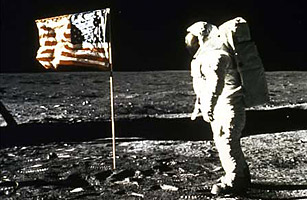
Aldrin and Armstrong spent 2 1/2 hours on the moon.
July 20, 1969
Neil Armstrong meant to say "That's one small step for a man," adapting the phrase from a children's playground game. Instead, because of intense radio static, Mission Control in Houston — and the rest of mankind — heard, "That's one small step for ... man, one giant leap for mankind," which became one of the most famous sentences of the 20th century. If the audio failed, the images were indelible, as a camera mounted on the base of the lunar-landing vehicle beamed back the other-worldly milestone. Ohio-born Armstrong, then 38, had become the first earthling on the moon. He was almost immediately followed by Colonel Edwin (Buzz) Aldrin, who helped plant a U.S. flag, signifying to all the world that America had won the race that had begun 12 years earlier with the launch of the Soviet Union's Sputnik.
There were three reasons that Armstrong — a naval aviator in the Korean War who had flown 78 combat missions — became the first to step on the moon. He had returned to civilian life, and the Nixon Administration, mired in the Vietnam War, did not want a commissioned officer "militarizing" space. Second, his reticent manner was considered ideal for coping with the demands of celebrityhood. Third, and most practical, as mission commander he was physically closer to the hatch of the Eagle and had to be the first out. Since Armstrong was assigned to handle the camera, most of the pictures from that famous mission are of Aldrin, with Armstrong seen only as a reflection on the colonel's helmet. With Michael Collins, who piloted the command module above them, the astronauts of Apollo 11 became latter-day Lindberghs, receiving parades and honors in 22 countries. Twelve other men would walk on the moon, the last in 1972.
Douglas Brinkley is a professor of history at the University of New Orleans who interviewed Neil Armstrong for a NASA oral history project